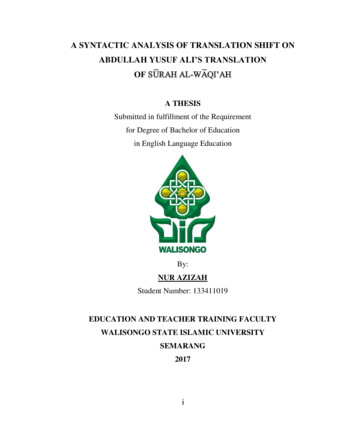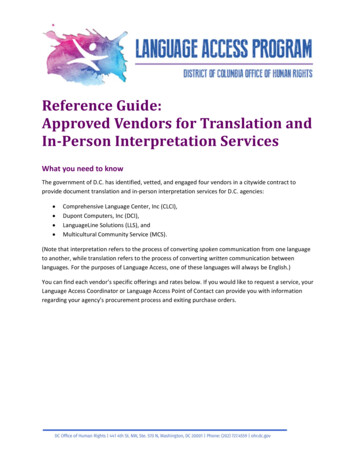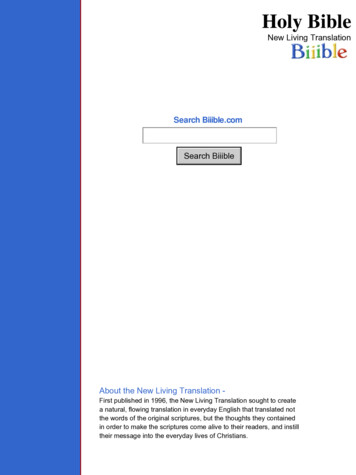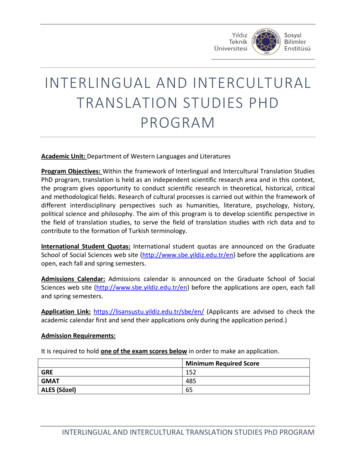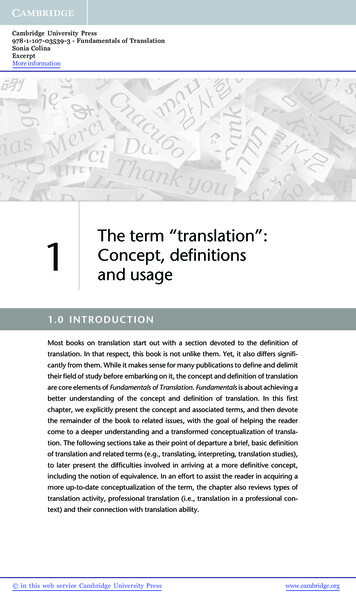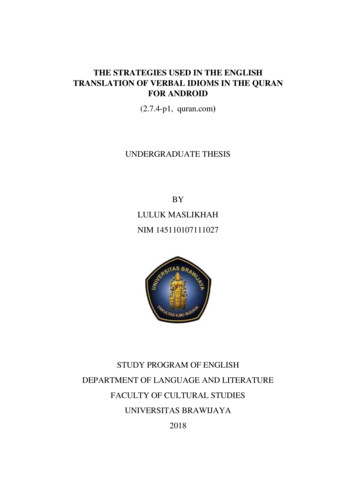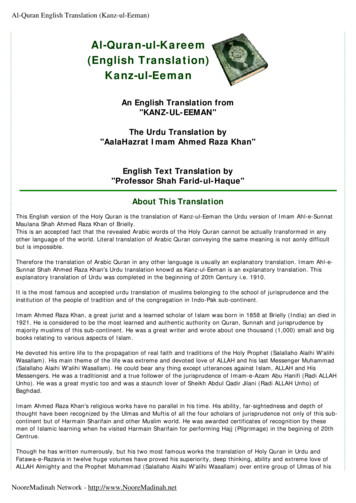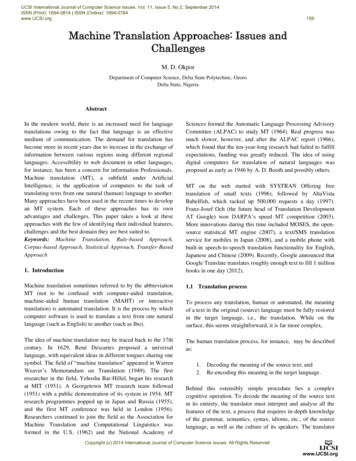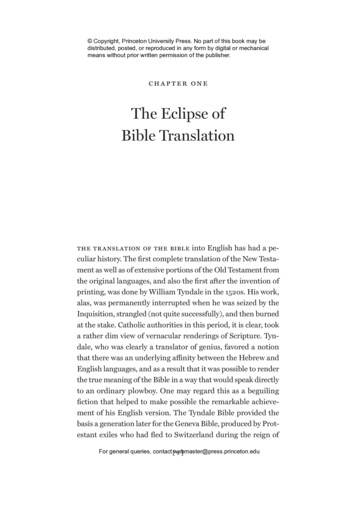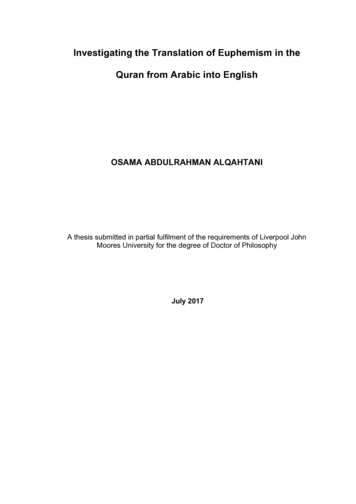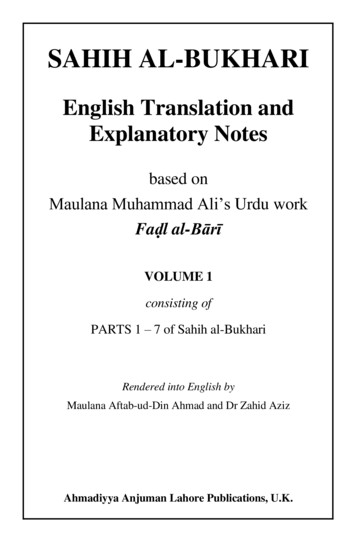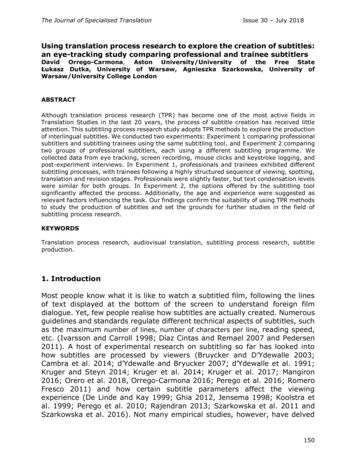
Transcription
The Journal of Specialised TranslationIssue 30 – July 2018Using translation process research to explore the creation of subtitles:an eye-tracking study comparing professional and trainee subtitlersDavid Orrego-Carmona,Aston University/University of the Free StateŁukasz Dutka, University of Warsaw, Agnieszka Szarkowska, University ofWarsaw/University College LondonABSTRACTAlthough translation process research (TPR) has become one of the most active fields inTranslation Studies in the last 20 years, the process of subtitle creation has received littleattention. This subtitling process research study adopts TPR methods to explore the productionof interlingual subtitles. We conducted two experiments: Experiment 1 comparing professionalsubtitlers and subtitling trainees using the same subtitling tool, and Experiment 2 comparingtwo groups of professional subtitlers, each using a different subtitling programme. Wecollected data from eye tracking, screen recording, mouse clicks and keystroke logging, andpost-experiment interviews. In Experiment 1, professionals and trainees exhibited differentsubtitling processes, with trainees following a highly structured sequence of viewing, spotting,translation and revision stages. Professionals were slightly faster, but text condensation levelswere similar for both groups. In Experiment 2, the options offered by the subtitling toolsignificantly affected the process. Additionally, the age and experience were suggested asrelevant factors influencing the task. Our findings confirm the suitability of using TPR methodsto study the production of subtitles and set the grounds for further studies in the field ofsubtitling process research.KEYWORDSTranslation process research, audiovisual translation, subtitling process research, subtitleproduction.1. IntroductionMost people know what it is like to watch a subtitled film, following the linesof text displayed at the bottom of the screen to understand foreign filmdialogue. Yet, few people realise how subtitles are actually created. Numerousguidelines and standards regulate different technical aspects of subtitles, suchas the maximum number of lines, number of characters per line, reading speed,etc. (Ivarsson and Carroll 1998; Díaz Cintas and Remael 2007 and Pedersen2011). A host of experimental research on subtitling so far has looked intohow subtitles are processed by viewers (Bruycker and D’Ydewalle 2003;Cambra et al. 2014; d’Ydewalle and Bryucker 2007; d’Ydewalle et al. 1991;Kruger and Steyn 2014; Kruger et al. 2014; Kruger et al. 2017; Mangiron2016; Orero et al. 2018, Orrego-Carmona 2016; Perego et al. 2016; RomeroFresco 2011) and how certain subtitle parameters affect the viewingexperience (De Linde and Kay 1999; Ghia 2012, Jensema 1998; Koolstra etal. 1999; Perego et al. 2010; Rajendran 2013; Szarkowska et al. 2011 andSzarkowska et al. 2016). Not many empirical studies, however, have delved150
The Journal of Specialised TranslationIssue 30 – July 2018into the subtitle production process and addressed some basic questions: Whatexactly do subtitlers do when they subtitle? How different are their workflows?How much is the subtitling process software-dependent? What exactly is it thatdistinguishes professional subtitlers from trainees? In this paper, we addressthese questions in more detail by reporting results of an exploratory study onsubtitling process we carried out on a group of professional and traineesubtitlers.2. The exploration of processes in subtitlingResearchers in translation studies have relied on cognitive sciences,psychology, psycholinguistics, neuroscience, and neighbouring areas to studythe process of translation (Jakobsen 2001, Hvelplund 2014; O’Brien 2015,Ehrensberger-Dow and Hunziker Heeb 2016). Aiming to understand howtranslators and interpreters process the information in the source whilesimultaneously or consecutively producing a target version, different modes ofwritten translation and interpreting have been investigated using techniquessuch as direct observation, think-aloud protocols, keystroke logging, eyetracking and, more recently, fMRI and EEG (Saldanha and O’Brien 2013). Thishas led to a considerable amount of research describing different aspects ofthe translation process, the stages of the production of a translation and thestrategies adopted by translators when completing their tasks. However, thismovement towards the exploration of the cognitive processes involved intranslation have almost completely eluded audiovisual translation in generaland subtitling in particular (Kruger and Kruger 2017). Only now are we startingto see how audiovisual translators deal with polysemiotic texts, how theyengage with the different semiotic codes in audiovisual texts and how theyovercome the issues arising in the translation of audiovisual products.When creating subtitles, subtitlers face the task of conveying the meaning thatis transmitted not only through the verbal linguistic channel but also that ofthe signs transmitted through other semiotic channels (Chaume 2004:16).Subtitlers have to coordinate the linguistic input with the visual and acousticinformation and then create a segmented target text that will function as partof the resulting polysemiotic text.Subtitles are created using specialised software programmes, so a solidtechnological competence (EMT 2009) is required. Subtitling software makesit easier for the subtitler to manage the material (video file, source texttranscription) and produce the subtitles; it makes it possible to segment andsynchronise the subtitles and it allows an immediate visualisation of theresults. Additionally, some programmes can also display an audio wave of thesoundtrack, which provides a visual representation of the sound to helpsubtitlers in the process of segmenting and synchronising the text.151
The Journal of Specialised TranslationIssue 30 – July 2018The translated subtitle output should additionally comply with a set of spatialand temporal constraints (Díaz Cintas and Remael 2007). Subtitlers normallywork with a predefined guide that establishes the number of lines, charactersper line and display time according to the product, medium, client or specificrequirements. Subtitles are presented on the screen as segmented units ofinformation, synchronised to the speech in the product. The onset and end ofthe utterances in the dialogues serve as a guide for defining the entry and exittimes of the subtitles. Although subtitling guidelines include some rules on thesegmentation and there are natural linguistic breaks in the speech that promptsubtitlers to end one subtitle and start another, segmentation is subjective tosome extent and might vary depending on translator’s personal preferences,particularly when dealing with continuous and fast-paced speech.Apart from the differentiating aspects mentioned above, subtitling shares theessential characteristics with other forms of interlingual translation. During thesubtitling process, subtitlers use the same resources used by other translators:a translation brief or a set of instructions, printed and online dictionaries, styleguides or manuals, as well as reference works. Similarly to other types ofinterlingual translation, subtitlers must also be equipped with culturalcompetence to ensure that the final product is appropriate for the targetaudience.Exploring the subtitling process can help us better understand how subtitlersoperate when they face a series of stimuli from different semiotic channels andhave to cope with an array of specific technical, linguistic and formalrequirements that are part and parcel of subtitling. Tapping into the creationof subtitles and scrutinising the processes behind it offer benefits for subtitlers,trainers, trainees, translators and subtitling tool developers. This ultimatelyhas implications for usability testing, subtitler training, and translationpedagogy.To the best of our knowledge, only a handful of previous studies employed thetranslation process research framework in the field of audiovisual translation.In a study conducted in Brazil, Pagano et al. (2011) used screen recording andquestionnaires to compare the performance of three professional and threenovice subtitlers working with Subtitle Workshop. They analysed the tasksinvolved in the subtitling process using the three production phases proposedby Jakobsen (2002): orientation, drafting and end-revision. They found that“professionals enact a pattern of shorter total time for task execution, longerrevision phase and attention to spotting during the end-revision phase”(Pagano et al. 2011:153).152
The Journal of Specialised TranslationIssue 30 – July 2018In his study using seven MA students from the University of Copenhagen,Hvelplund (2017) used eye tracking to analyse the distribution of attentionand cognitive effort involved in the process of translating audiovisual contentfor dubbing. He found that “novice dubbing translators spend the majority ofthe translation process working with the TT, followed by ST processing andthen the audiovisual material” (2017). Pupil size indicators in his study suggestthat, even though little time is dedicated to the video while translating, thisseems to be the most cognitive-taxing task performed by the participants.In a small-scale study on in-house professional subtitlers using TitleVision2000 software in Denmark, Beuchert (2017) employed screen recordings andcue-based retrospective interviews. In terms of the subtitling process, shefound that subtitlers tended to have a pre-spotting phase, where they roughlyspotted a scene first, paying a lot of attention to shot changes, then filled thesubtitles with translation and went on to improve spotting. The author alsoexplored a myriad of aspects related to the work process of subtitlers: fromworkplace ergonomics, workflows, software, keyboard shortcuts, throughlinguistic and translation aspects, such as text reduction and condensation, torates, subtitling brief, and employment conditions.A study by Szarkowska et al. (forthcoming) examined the distribution of visualattention in intralingual respeaking during a live subtitling task. Using eyetracking and post-task interviews, the authors established that people withexperience in pre-recorded subtitling managed their visual attention moreefficiently by fixating on key screen areas, such as subtitles. They also hadlonger fixation duration on subtitles than other groups, which may be anindication of deeper processing and higher expertise (Holmqvist et al. 2011).3. Overview of the studyThe primary goal of this study is to explore the subtitling process, focusing onhow it might be affected by experience and subtitling tools. With this goal inmind, relying on the translation process research framework, we conductedtwo experiments:-Experiment 1: comparing professional subtitlers and trainees, usingthe same subtitling programme (EZTitles)Experiment 2: comparing professional subtitlers using two differentsubtitling programmes (EZTitles and EdList)1We follow a mixed-methods approach combining qualitative and quantitativeanalyses to assess the data. In Experiment 1, we hypothesised that – giventheir technological and linguistic expertise – professionals would complete thetask faster than trainees and that the subtitled text they produce would be a153
The Journal of Specialised TranslationIssue 30 – July 2018more condensed version of the original. We were also interested in findingwhether the subtitling workflow differs between professionals and trainees,and how each group allocated attention to the different areas of the screen. InExperiment 2, when comparing the professional subtitlers working with twodifferent types of subtitling software, we wanted to see how the subtitlingprocess was affected by the type of tool. For this, we used the two mostcommon subtitling programmes used by subtitlers on the Polish market:EZTitles and EdList.To the best of our knowledge, this study constitutes the first attempt toempirically analyse the subtitling production process with the use of eyetracking technology. In this exploratory study, we shed some light on theprocess of creating subtitles and discuss a few methodological issues weencountered when applying translation process research methods to the studyof subtitling. The study may have direct implications for subtitler training andsubtitling software development; it may also bring improvements to thesubtitler work environment.3.1 ParticipantsA total ten professional subtitlers (9 women and 1 man) and five subtitlingtrainees (4 women and 1 man) took part in the experiments. Among theprofessionals, 6 participants used EZTitles and 4 used EdList. The mean ageof the professionals using EZTitles was 29.33 years (SD 6.9), while for theprofessionals using EdList it was 42.75 years (SD 11.9). The trainees were22.6 (SD 0.55) years old on average.The professionals were recruited on the understanding that their main sourceof income is related to translation tasks. They were contacted through themailing list moderated by the Polish Association of Audiovisual Translators(STAW). The trainees were all enrolled in the MA translation programme at theInstitute of Applied Linguistics at the University of Warsaw. At the time of theexperiment, all of them had completed an optional 30-hour subtitling courseas part of their MA studies. All the participants worked with the English-Polishlanguage combination.3.2 Subtitling task and materialParticipants were asked to spot and to translate a video from English to Polish.The video lasted 85 seconds and was taken from the first episode of the HBOseries The Newsroom (Sorkin, 2012). The video segment was selected becauseit contained fast-paced dialogue with specialised terminology in a newsroomsetting. The video was short in order to minimise fatigue. The participantswere provided with the English transcription, which was 354-word (1778154
The Journal of Specialised TranslationIssue 30 – July 2018characters) long and consisted of plain text only, without any subtitlesegmentation or time codes.3.3 ProcedureThe participants were tested individually in a soundproof research lab (see Fig.1) at the Institute of Applied Linguistics, University of Warsaw, in Novemberand December 2015. Upon arrival, each participant received an informationsheet about the study and signed an informed consent form. The session wasdivided into three stages. First, participants filled out a questionnaire coveringthe demographic information and professional experience. Then, theycompleted the subtitling task and finally, they had an interview with theresearchers.For the experiment, the participants could type on the laptop’s keyboard orthey could use an external keyboard and a mouse, depending on theirpreference. They were allowed to use the Internet. No time limit was set. Theparticipants were instructed that when using the Internet, they needed toadjust the browser window so that it covers the entire screen. Thus, all thefixations that occur at times when the participant is using the internet aremade inside the browser since nothing else is visible on the screen. All thisinformation was explained to the participants before starting the recording andwas also shown to them on the screen before starting the experiment and afterthe calibration of the eye tracker.The participants were told to use the following settings in the subtitlingsoftware: maximum two lines in a subtitle and 37 characters per line,maximum reading speed of 15 characters per second (including spaces).Fifteen characters per second is a standard setting on Polish television(Szarkowska 2016), which was also confirmed by participants in post-testinterviews.3.4 ApparatusThe participants worked on a laptop connected to an SMI RED 250 mobile eyetracker, which was used to record their eye movements during the translationsession. Participants’ eye movements were recorded with the sampling rate of250Hz. We used SMI software package Experiment Suite to create and conductthe experiment, and SPSS v. 24 to analyse the data.Regarding the subtitling software used, in Experiment 1, the participantscompleted the task using EZTitles (manufactured by EZTitles DevelopmentStudio, version 4), while in Experiment 2, one group of participants usedEZTitles and the other group used EdList.155
The Journal of Specialised TranslationIssue 30 – July 2018Figure 1. Experimental set up.The procedure and apparatus were pilot tested with an additional professionalsubtitler who fit the profile defined for the study. This test helped us to refinethe protocols and ensure the setup was comfortable for the participants.Although we did not change the structure of the study, the results from thisparticipant were not included in the analysis since she was not briefed followingthe same procedure as the remaining participants. After the pilot, additionalon-screen tests were added to the experiment in order to make sure that thetask instructions were clear for the participants.3.5 DesignThe study followed a between-subject design with group as the mainindependent variable: professionals vs. trainees in Experiment 1, andprofessionals using EZTitles vs. professionals using EdList in Experiment 2. Thedependent variables used to assess the process of subtitling were categorisedunder three types of effort adapted from Krings (2001): temporal, cognitiveand production (see also Table 1). Temporal effort was measured as task completion time, i.e. the totalamount of time that participants took to complete the task. Longer timesto complete the task could indicate less experience. We expected traineesto have significantly longer times than professionals in Experiment 1, butprofessionals in Experiment 2 to perform similarly. Cognitive effort was measured using two eye-tracking variables: meanfixation duration and dwell time2, calculated based on different areas ofinterest (AOIs) on the screen, particularly the subtitles and the video.According to Hvelplund, “in translation process research using eyetracking data, fixation duration and fixation count are [.] often taken to156
The Journal of Specialised TranslationIssue 30 – July 2018index cognitive effort” (2014: 212). Higher mean fixation duration andlonger dwell time can be taken as an indication of higher cognitive effort(Holmqvist et al. 2011). We also measured the amount of time spentdoing research on the Internet as a percentage of task completion timeto examine the allocation of attention during the subtitling process. Production effort was operationalised using mouse clicks and keylogging,a traditional method to analyse effort in translation process research(Lacruz 2017). Keystrokes were recorded using SMI Experiment Centerand analysed in combination with mouse clicks as events of userinteraction with the software. Another production effort indicator ofsubtitling competence we included in the study was text reduction, basingon the assumption that it is one of the key aspects that novice subtitlersneed to master (Díaz Cintas and Remael 2007). Text reduction wascalculated as the difference between the number of characters in theEnglish transcription (source text) and the number of characters in thesubtitles (target text).For the qualitative part of our study, we examined the structure of thesubtitling process as a whole. We wanted to know how professionals andtrainees divided the subtitling process and whether there were any differencesin how they did it. With this goal in mind, we analysed the different stages ofthe process qualitatively and studied how the subtitlers tackled the differentstages, such as the first viewing of the original video, spotting, translation andrevision.Type ofeffortVariableUnitOperationalisationTemporalTask completiontimeMinutesTime taken to translate and spot thevideo, and to produce a target textsubtitle fileCognitiveMean fixationduration per AOIMillisecondsMean fixation duration for each AOI onthe screen per participantCognitiveRelative dwell timeper AOIPercentagePercentage of time spent in an AOI(subtitle and video) relative to the totaltask duration as an indicator of visualattention allocationCognitiveRelative time usingthe InternetPercentagePercentage of time spent using theInternet over the task completion timeas an indicator of attention allocationProductionAverageinteraction eventsNumber ofinteractioneventsAverage interaction events (the sum ofall keystrokes and mouse clicks) pergroup157
The Journal of Specialised TranslationIssue 30 – July 2018ProductionMouse clicks/interaction eventsPercentageAverage mouse clicks over total eventsratioProductionText reductionNumber ofcharactersAverage number of characters in thetarget text over the number ofcharacters in the source textTable 1. Operationalisation of dependent variables per type of effort3.6 Data analysisAll eye tracking data were extracted from Areas of Interest defined on differentareas of the screen (see Figure 2 and Figure 3): the toolbars, the audiowave,the subtitle panel (the list of the subtitles in the file), the subtitle area (wherethe text of the currently selected subtitle is shown and can be edited) and thevideo.Participants with tracking ratio below 80% were excluded from the eyetracking analyses (but not from other analyses). Owing to the poor quality ofeye tracking data, three participants had to be excluded from the eye-trackingdata analyses: P02 and P12, who were professionals working with EZTitles,and N05, a trainee also working with EZTitles. These participants were notexcluded from other analyses, such as task completion time or text reduction.Figure 2. Areas of interest in EZTitlesIn the case of EZTitles, given that the subtitle which is being edited is shownover the video (so that the subtitler can see how the subtitle would look likeand how much of the image it would cover), the subtitle area and the videooverlap. Thus, the video AOI for EZTitles refers to the part of the image which158
The Journal of Specialised TranslationIssue 30 – July 2018is not being covered by the subtitle at a given time. As the subtitler was editingtheir translation, the part of the image that was covered changed. To take thatinto account, the video AOI and the subtitle area AOI were drawn as dynamicareas of interest, and they were adjusted to follow the editing process. A videoclip illustrating how dynamic AOIs were adjusted depending on theparticipants’ actions can be viewed here.Figure 3 shows the initial screen setup used for EdList. The EdList window haslimited resolution and the user cannot enlarge the software window to fill thewhole screen. The participant’s screen displays the transcription in English ina Word document side by side to the EdList window. For EdList, there werefour AOIs: the toolbar, subtitles, video, and transcription.Figure 3. EdList setupBoth for subtitlers working with EdList and EZTitles, an additional area ofinterest was drawn for the entire screen when participants used the Internet.4. Results and discussion4.1 Experiment 1: Professionals and traineesIn this experiment, we compared the performance of six professionals and fivetrainees completing the subtitling task described in 4.1. Both groups ofparticipants used EZTitles and followed the same procedure.4.1.1 Temporal effortTask completion timeTo see whether professionals were faster than trainees, we measured how longit took both groups to complete the task (see Table 2). Using an independent-159
The Journal of Specialised TranslationIssue 30 – July 2018samples T test, we found that the professionals (M 60.70 minutes, SD 13.38)were faster than trainees (M 76.84 minutes, SD 10.07). The difference wasborderline significant (t(9) -2.17, p 0.05), which we attribute to the smallsample size.GroupProfessionalsTraineesnMean (minutes)SDMinimum660.7013.38576.8410.07Table 2. Task completion time by group3961Maximum7484A visual inspection of the results shows a large variation among participants.The fastest professional subtitler completed the task in about 39 minutes, butanother person took as long as 74 minutes. In the case of the trainees, thetask completion time ranged from 61 to 84 minutes. These results thereforeneed to be treated as indicative and replicated on a larger sample ofparticipants. Time constraints are known to affect translation processes(Hvelplund 2011) and future studies could explore whether setting a time limitaffects the subtitlers’ work.4.1.2 Cognitive effortTo find out if the subtitling process was more effortful for the trainees than forthe professionals, we analysed their mean fixation duration and the time theyspent looking at different screen areas. We also measured their use of theInternet as an indicator of attention allocation during the subtitling process.Mean fixation duration on AOIsAs is typical in TPR (Hvelplund 2014), we compared whether there was anysignificant difference in the mean fixation duration between the two groups foreach AOI. Table 3 presents the mean fixation duration for the AOIs averagedper participant. Independent t-test showed no between-group differences onany of the AOIs: Video (t(6) -0.461, p 0.6), Subtitles (t(6) 1.805, p 0.1)or Internet (t(6) 0.971, p 0.4). Even though the results did not reachstatistical significance, the descriptive statistics may point to some interestingdifferences. For example, mean fixation duration was longer on the subtitlesAOIs for professionals compared to trainees, which may indicate deeper andmore efficient processing. It is also in line with previous studies showing thatexpertise – in various fields like art, chess and goalkeeping – leads to longerfixation durations (see Holmqvist et al. 2011:383).To uncover any potential differences in participants’ cognitive load whenlooking at the different areas of the screen, we conducted a paired-samples Ttest. Descriptive statistics show that participants had a longer mean fixation160
The Journal of Specialised TranslationIssue 30 – July 2018duration on the video area (M 213.4, SD 66.27) than on the subtitles(M 201.45, SD 30.59), but the comparison of the mean did not reachsignificant results (t(7) -0.564, p 0.59). Yet, this may be an indication ofdifferent behaviours between professionals and trainees that could be exploredin future studies on larger samples.ParticipantToolbarAudio 30-175.66-184.47-224.87-195.62Mean*Note: In Participant ID column, P stands for ‘professional’ and T stands for ‘trainee’Table 3. Mean fixation duration (in milliseconds) per area of interestDwell time on AOIs as a percentage of total dwell timeWhen comparing the time that participants spent on the subtitles and on thevideo, we considered the relative time they dedicated to these AOIs out of thetotal time spent on the task (Table 4).P02Dwell time (%)on subtitles--Dwelltime(%) on video--Dwell time (%)on the 954.5511.98Table 4. Mean dwell time on the internet, subtitle area and video161
The Journal of Specialised TranslationIssue 30 – July 2018The analysis of the percentage of dwell time on the subtitles did not show anysignificant differences (t(6) 0.566, p 0.15). On average, the participantsspent about a third of their time gazing at the subtitles: the professionalslooked at the subtitles for 25.53% of the time and the trainees 30.95% of thetime. The time spent by both groups looking at the video was similar.Interestingly, the participants only looked at the video for about 4% of thetotal task duration, which may come as a surprise considering the importanceof the images for subtitling. Finally, trainees spent relatively less time doingInternet search compared to the professionals, who devoted about 20% oftheir time to this stage of subtitling.Relative time using the InternetWe also wanted to know how the two groups used the Internet for subtitling.Our assumption was that professional subtitlers would use Internet resourcesmore than trainees, as expertise would make them more conscious not onlyabout what they do not know but also about what they need to double check.An independent-samples T test showed a significant difference in the relativetime using the Internet between professionals (M 20.66, SD 5.39) and thetrainees (M 11.98, SD 4.49), t(9) 2.68, p 0.019, d 1.75. The professionalsubtitlers spent twice as much time as trainees on using Internet resources.Figure 4 shows a visual representation of the segmentation of the subtitlingprocess. The blocks in navy blue depict the instances in which the participantsused the internet.Figure 4. Distribution of attention between AOIs covering subtitling software(‘toolbar,’ ‘audiowave,’ ‘subtitles panel,’ ‘subtitles,’ ‘video’) and the browser(‘internet,’ shown in navy blue) for participants N02 (on the left) and P07 (on theright).Despite our predictions, we found little variation between professionals andtrainees in terms of the type of online resources used. Both professionals andtrainees relied largely on Google and Wikipedia as their main sources ofinformation. A typical pattern we observed in many participants was that they162
The Journal of Specialised TranslationIssue 30 – July 2018looked for an English term in Wikipedia, and then switched language to Polish,as shown in Video 2 from a trainee using Wikipedia here.Google was used both as a search engine to find websites providinginformation about the content of the video or to solve specific doubts and as acorpus to confirm equivalence and linguistic decisions. Some particip
David Orrego-Carmona, Aston University/University of the Free State Łukasz Dutka, University of Warsaw, Agnieszka Szarkowska, University of Warsaw/University College London ABSTRACT Although translation process research (TPR) has become one of the most active fields in . to see how audiovisual translators deal with polysemiotic texts, how they
